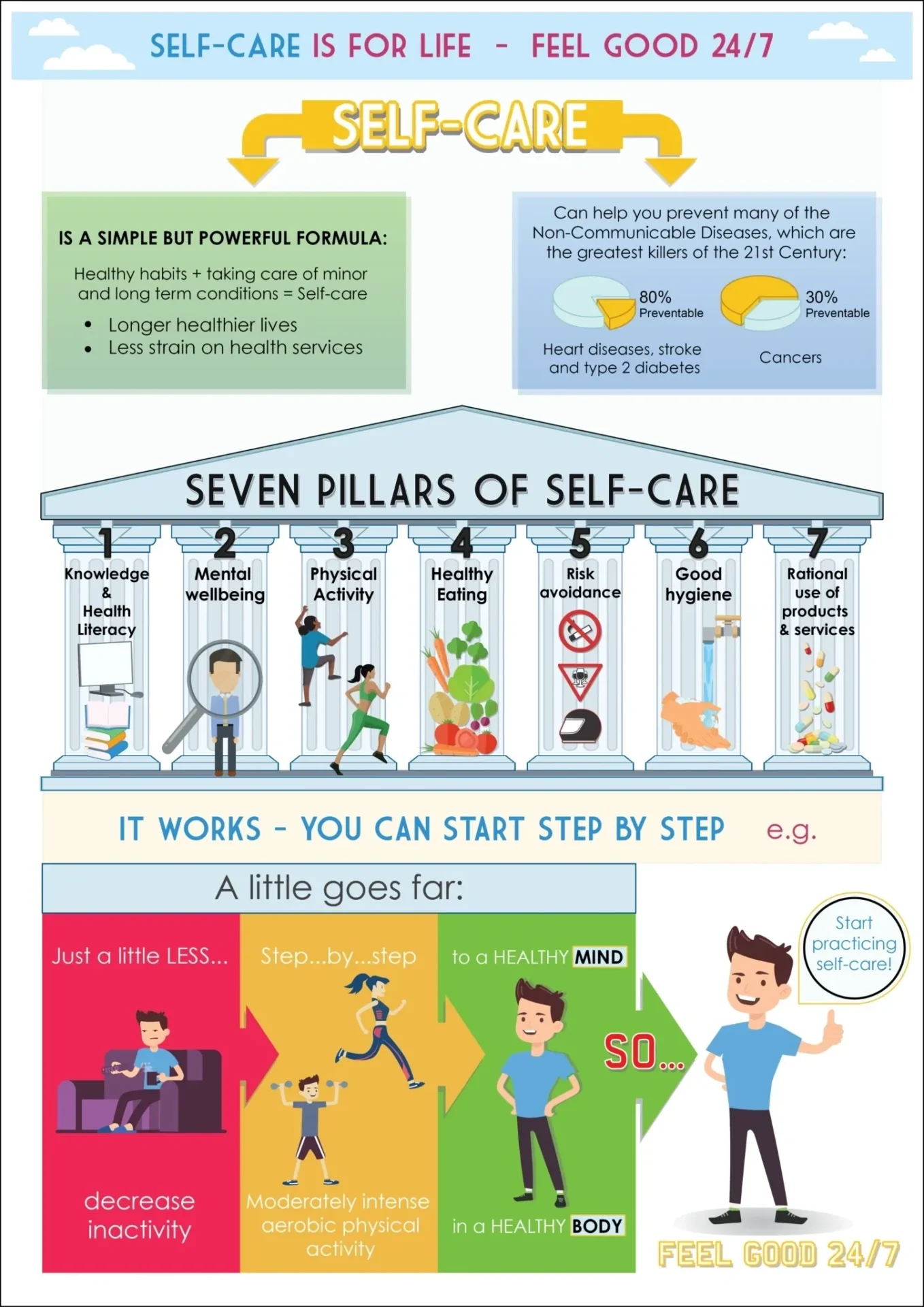
More About Self-Care History
Self-care is not a new activity. People have necessarily managed their own health since the beginning of mankind. Throughout human history, the dominant paradigm of healthcare was individual self‐care in the family and local community. Treatment involved self-medication with locally‐produced preparations of generally uncertain efficacy. People themselves were responsible for their own health, and that of their families, as self-sufficiency was obligatory and almost universal. The opportunity and need for improvement were great.
Starting in the 19th Century and carrying on through the 20th Century, healthcare was revolutionized by scientific and medical discoveries, technological advances in diagnostics, surgery and medicines, and the development of the healthcare professions. Patients gratefully placed themselves into the hands of doctors and took the effective, newly‐developed medicines they prescribed. The role model of the patient as a largely passive recipient of public services was complemented by the mystique of the expert healing physician. At the low point of self‐care – around the 1960s in the West – self‐care and self-medication were regarded as unnecessary and potentially even unhealthy practices. This paternalistic approach to medicine, supported by health systems designed to treat sickness (rather than to prevent disease) remains a familiar aspect of healthcare in many countries to this day.
Circumstances and societies are ever-changing, however. The paternalistic approach to medicine is expensive when applied to entire populations, especially in aging countries. People around the world are better educated and want more information, choice, and control over their lives – not least in the area of health. Chronic ‘lifestyle’ conditions such as cardiovascular disease, cancer, and diabetes are taking over from infectious diseases as the primary cause of death and disability in most countries. These chronic noncommunicable diseases are significant in that they are substantially preventable through better ‘self‐care’ – by individuals avoiding risks such as smoking and obesity. The paternalistic approach and health systems that provide ‘sickness services’ are becoming less well‐attuned to the 21st Century’s health challenges and needs.
As a result, over the past 40 years, there has been a pushback against the paternalistic model of health, toward a more person‐centric approach involving self‐care. A patient’s needs and rights have become central considerations and run through many of today’s initiatives in health – in medical ethics, patient autonomy, and ‘person or patient‐centered medicine’. Of course, along with patient’s rights comes responsibilities. There has been a growing realization that personal self‐care in the home environment and community setting should be the starting point of healthcare, and is in fact the foundation for people to manage lifelong health. Initiatives in ‘community healthcare’ and ‘health promotion’ are aspects of the new approach.
Why is Self-Care Essential?
Lifestyle diseases – heart attack and stroke, cancer, chronic respiratory disease, and diabetes – represent 63% of all annual deaths worldwide, causing an estimated 36 million deaths every year out of the global total of 57 million (WHO 2010). In industrialized countries this figure is much higher – 88% of deaths in the case of the U.K.
And the trend is getting worse, with deaths from lifestyle diseases projected to increase by 15% globally by 2020.
The United Nations in 2011 held meetings in Moscow and in New York to discuss the challenge of lifestyle diseases. Normally the responsibility of the World Health Organization, this was only the second time in history that a high-level UN meeting was dedicated to a health topic, the first being HIV/AIDS in 2001. One driver for the U.N. engagement was that the economic impact of lifestyle diseases is so great that this demands a broader-than-health approach.
Total global health expenditure amounts to about 10% of global GDP (World Bank), and this would increase unsustainable if the lifestyle disease epidemic proceeds at current rates. The challenge is not just millions of premature deaths, but also deaths of people in their prime in economic terms (prior to age 60). Half of those who die of lifestyle diseases are in their prime, representing a huge financial cost to society in lost productivity. The World Economic Forum and Harvard Medical School published a report on the Global Economic Burden of Non-Communicable Diseases in 2011. They found that over the next 20 years, NCDs would cost more than $30 trillion, representing 48% of the world’s total GDP in 2010, and pushing millions of people below the poverty line.
The U.N. meeting recognized that focusing solely on treating lifestyle diseases would not be a sufficient or desirable approach. Lifestyle diseases are in fact preventable – up to 80% of heart disease, stroke, and type-2 diabetes, and over a third of cancers could be prevented by eliminating shared risk factors, particularly tobacco use, unhealthy diet, physical inactivity, and the harmful use of alcohol.
The ‘Political declaration of the High-level Meeting of the General Assembly on the Prevention and Control of Non-communicable Diseases,’ September 2011 fully recognizes the necessity for prevention, e.g. in article 34: “Recognize that prevention must be the cornerstone of the global response to non-communicable diseases.”
In May 2013, the World Health Assembly endorsed the WHO Global Action Plan for the Prevention and Control of NCDs 2013-2020. The Global Action Plan provides countries, international partners, and the WHO with a road map and menu of policy options to tackle NCDs. Nine global targets have been set for 2025, including an overall reduction of 25% in the mortality from NCDs. Specific targets include a 10% reduction in the prevalence of insufficient physical activity, a 30% reduction in salt intake and tobacco use, and a halt in the rise of obesity. These challenging targets can only be met through the adoption by people of healthier lifestyles – in other words, through self-care. Evidently, self-care is essential!

